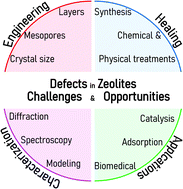Silanol defect engineering and healing in zeolites: opportunities to fine-tune their properties and performances
Abstract
Zeolites have been game-changing materials in oil refining and petrochemistry over the last 60 years and have the potential to play the same role in the emerging processes of the energy and environmental transition. Although zeolites are crystalline inorganic solids, their structures are not perfect and the presence of defect sites – mainly Brønsted acid sites and silanols – influences their thermal and chemical resistance as well as their performances in key areas such as catalysis, gas and liquid separations and ion-exchange. In this paper, we review the type of defects in zeolites and the characterization techniques used for their identification and quantification with the focus on diffraction, spectroscopic and modeling approaches. More specifically, throughout the review, we will focus on silanol (Si–OH) defects located within the micropore structure and/or on the external surface of zeolites. The main approaches applied to engineer and heal defects and their consequences on the properties and applications of zeolites in catalysis and separation processes are highlighted. Finally, the challenges and opportunities of silanol defect engineering in tuning the properties of zeolites to meet the requirements for specific applications are presented.



 Please wait while we load your content...
Please wait while we load your content...